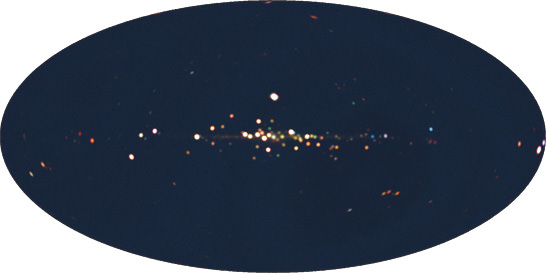[/caption]
The Monitor of All-sky X-ray Image, or MAXI for short, spends its time aboard the ISS conducting a full sky survey every 92 minutes. Its sole purpose is to monitor X-ray source activity and report. Unlike stars seen in visible light, X-ray sources aren’t evenly distributed and can exhibit some highly unusual behavior. What causes these erratic moments? Read on…
“Most visible stars shine with energies generated by nuclear fusion in their cores. In these stars, if the energy generated in their core increases more than usual, the whole object expands and eventually lowers the core temperature. In this way, negative feedback is activated to stabilize the nuclear reaction. For this reason, these stars shine very stably for most of their lifetime.” says Nobuyuki Kawai of the Tokoyo Institute of Technology. “On the other hand, the energy source of most intense X-ray sources is gravitational energy released when the gas surrounding extremely compact bodies like black holes and neutron stars is accreted onto them. The normal stars’ stabilizing mechanism does not work in this process, and accordingly, X-ray intensity fluctuates in response to changes in the supply of gas from the surrounding area.”
This means MAXI needs to keep a close watch on both known and unknown X-ray sources for activity. Catching it as it happens allows an alert to be posted to other observatories for monitoring and study. Right now the focus has been on MAXI’s 18 month study of black hole binaries – the most famous of which is Cygnus X-1. It is well-known this famous source shines brilliantly in the X-ray spectrum, but it switches between a “hard” and “soft” state. These periods of high and low energy may be directly related to the density of gas which surrounds it.
“We can get a clue to estimate the mass of a black hole by examining the X-ray intensity and radiation spectrum in the soft state. As a result of analysis of the motion of the companion star rotating the center of gravity of the binary system, we found that Cygnus X-1 is a remarkably smaller object than normal stars, with an X-ray source mass about 10 times the solar mass but which emits hardly any visible light.” says Professor Kawai. “If applying star theory, such an object must be a black hole.”
Right now astronomers are studying gas properties and estimate there are about 20 binary X-ray sources other than Cygnus X-1. Most of these black hole binaries are considered to be “X-ray nova” – showing activity anywhere from every few years to only once in the four decades we’ve been studying them in this light. With the help of MAXI’s sensitive all-sky monitoring, researchers now stand a chance of being able to monitor activity from beginning to end. Has it been successful? You bet. When black hole binary, XTE J1752-223, was discovered by the routine patrol of RXTE, MAXI also detected the emergence of this new X-ray nova and was able to observe all the activities until it disappeared in April 2010. On September 25, 2010 MAXI and the Swift satellite discovered black hole binary MAXI J1659-152 almost simultaneously allowing it to be observed by researchers and amateur astronomers around the world.
“In addition to these black hole binaries, MAXI has achieved many interesting observations including: detection of the largest flare from active galactic nuclei in X-ray observation history; discovery of a new binary X-ray pulsar, MAXI J1409-619; and detection of a number of intense star flares.” says Kawai. “As long as the ISS is operating, we will use MAXI to monitor the X-ray sky, which changes restlessly and violently.”
Original Story Source: Japan Aerospace Exploration Agency.


John A. Wheeler used the metaphor of the ballroom or waltzing. The women wore white gowns which were visible while the men wore black tuxedos that were not visible. So th white women, meant to symbolize a star, would whirl around something invisible — the black hole. Given the extreme nature of black holes those in the white gowns are more fortunate than those in the tux’s.
LC
Yeah, especially if the poor guy in the tuxedo had to pay for both their outfits!
Black holes being the gravitational vacuum cleaners they are, if the dance is a close one the guy in the tux ends up eating the white outift.
LC
Yo Tammy, at the fourth paragraph:
Er… it appears that something was lost in the translation there; I think that should read: “As a result of analysis of the motion of the companion star [orbiting] the center of gravity of the binary system…”
Also, there’s a typo in the Original Story Source link: Aerospace, not “Aeorspace”.
hi, ivan! i changed my incorrect spelling, but not professor kawai’s quote. chances are that you’re right and it was a translation error – but i’d feel horrible if it were correct and i took liberties with a statement.